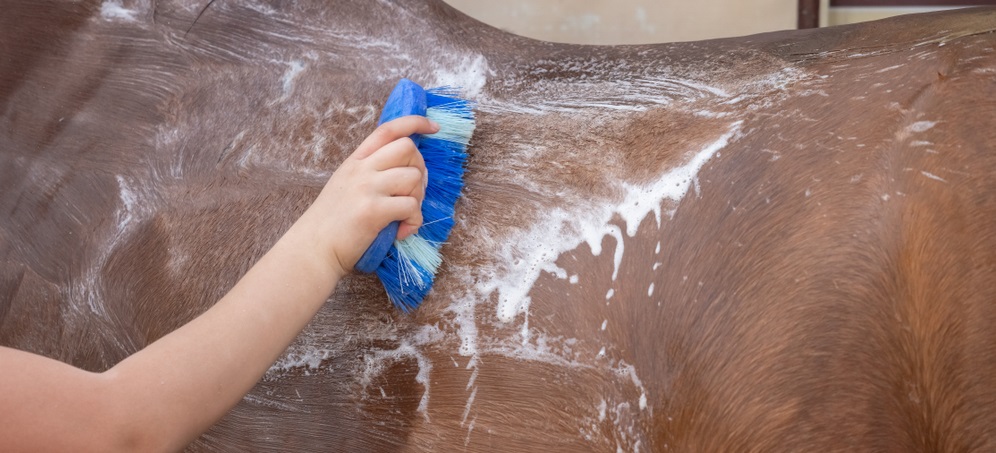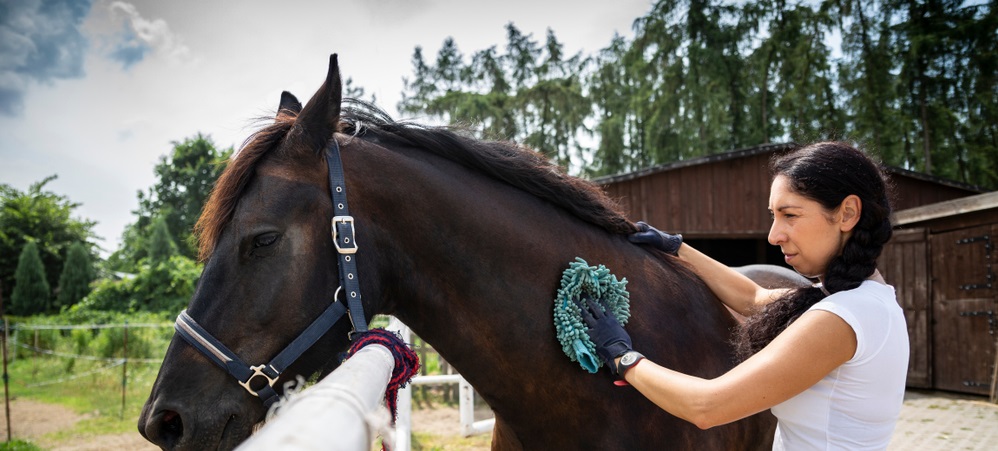Powered by Bestia Europe B.V.
How to Give a Horse a Bath...
Is your horse repulsed by the sight of a shower? Do you have an aquaphobic filly on your hands? If so, don’t be a nervous nelly—this is normal for horses. We’re here to not only show you how to give your horse a bath, but make bathtime fun and easy for the both of you.
Though horses don’t require frequent baths, bathtime is important for those days your horse is particularly dusty and sweaty (or when your horse suddenly decides to get into DIY mud baths). While they look dirty now, with a little suds action, you can transform your 1,000-pound smelly nelly into a prize pony in no time.
Read on to learn how to bathe a horse with this step-by-step guide.
How Often Should You Bathe Your Horse?
How frequently you bathe your horse depends on preference. Once a week is probably too often—you don’t want to strip your horse’s skin of the essential natural oils it produces to make their coat shiny and beautiful.1 Once a year, on the other hand, is far too infrequent. Not only can your horse’s mane become tangled, but it’s also important to clean your horse’s hooves to prevent potential hoof ailments or even worse, an infection. When giving your horse a bath, it’s always recommended to follow horse hoof cleaning techniques to maintain their health and well-being.
Evaluate how dirty your horse is by asking yourself a few questions:
- Is your horse itchy or uncomfortable?
- Do they seem extra sweaty and dusty?
- Did they roll in wet grass and mud recently?
- Did they roll in some other unidentified substance?
- Is it the end of spring, when their winter coat is likely shedding?
- Is your horse’s mane and tail begging for some detangling love?
If you answered yes to any of these questions, bust out the bucket and brushes. It’s time for a scrub down.
Prepare Your Station
Every successful horse bath starts with a successfully prepared station. It’s a lot like washing a car—you could go in immediately with the garden hose and old sponge, but you’ll likely miss a few spots.
For a deep clean, you’re better off with a fully equipped car wash, or in this case, a fully equipped stable.
To be well prepared for a horse bath, stock up on:
- A hose with an adjustable nozzle
- A large tub to fill with warm water
- A step stool to clean those hard-to-reach areas
- A rubber curry comb
- A rubber scrubbing mitt or grooming glove
- At least 4 big half-moon sponges for different areas of the body
- Vetericyn Foamcare Equine Shampoo
- A sweat scraper (wooden scrapers tend to be gentler than the metal kind)
- 2 full-sized towels
- A helping hand, in case your horse is nervous
Once you have all your materials, the last thing to confirm is that the weather is favorable. You wouldn’t want to shower outdoors on a frigid, windy day, and neither would your horse! Instead, look out for a sunny day when your horse can drip-dry comfortably. If the weather’s fair, you’re good to go.
Brushing and a Pre-Wash
Two vital steps will make the task of bathing easier and more effective from the get-go.
STEP #1
Use a rubber curry comb (horses can be sensitive to sharp metal combs) to brush out dust, dirt, and loose hair. Ensure your horse is not suffering from horse ringworm on it’s skin before brushing.
STEP #2
Fill your tub or buckets with warm water. Using a sponge, give your horse a good rinse. You can also rinse your horse with a hose, provided the stream is gentle and the temperature isn’t freezing cold. This will help remove everything you’ve brought to the surface with the comb.
- To rinse your horse, start at the hooves and work gently upward and outward. Don’t forget to soak the underside, between the legs, and the mane and tail.
- Make sure you never point the hose at your horse’s head. Horses need gentle cleaning action around the face, and you don’t want to make them skittish.
Now your horse will be much easier to clean, and soap will be able to penetrate the inner layers of their coat.
Lathering up with Equine Shampoo
Now that your horse is combed and pre-rinsed, they’re ready for suds. Ordinarily, you’d have to work hard with your sponge to create enough soapy lather for your horse’s whole body. Luckily, you can skip this step when you use Vetericyn FoamCare® Equine Shampoo.
This shampoo is an effective formula pioneered by horse owners for horses. It foams instantly, so instead of dumping who-knows-how-much soap into your bucket, you can spray the foam-based shampoo directly onto your horse and scrub the dust away.
If your horse has skin issues, you can also try Vetericyn FoamCare® Equine Medicated Shampoo. It has the same qualities as the original, plus the ability to treat itchy skin, fungal disorders, girth itch, and more.
While bathing your horse, make sure to check for any horse scratches or abrasions or rashes. The sooner you are able to spot and treat any skin problems, the faster they can be treated.
Scrubbing Your Steed
Once your horse is sufficiently lathered up, follow these steps to transform your steed into a stud…..or mare into a Beauty Queen.
STEP #1
Use a sponge to scrub your horse’s coat in a circular motion. Move from the neck to the rump, reapplying shampoo whenever you need it.3
STEP #2
Wash the legs, belly, genital area, and behind the elbows. Use a different sponge reserved for washing under the tail and between the hind legs.
STEP #3
Spray extra shampoo onto the tail and mane. Work the soap through the hair with clean water and comb out any tangles from the ends to the root. You can even spray a bit of shampoo into your hands to help with this part.
STEP #4
Using the rubber scrubbing mitt, go over your horse’s entire body. Re-wet often and really scrub to wash away dead skin, hair, and dirt.
STEP #5
When your horse is sufficiently scrubbed and lathered, use either a hose or clean sponge soaked in warm water to rinse out suds. Rinse from the front legs to the shoulder, move to the neck and mane, and finish with the back, flanks, legs, belly, and all around the tail.
Really make sure the soap suds get rinsed away—leftover soap, especially on the back and stomach, can irritate your horse’s skin.
And just like that, your horse is washed and rinsed! Arguably the hardest part of the bathing process, but it’s not over quite yet.
Washing Your Horse’s Face
Just like a car, your horse needs more than general body wash to get really clean: there’s a little detail work involved. Unlike a car, however, horses are super sensitive.
Now that your horse is wet and used to the scrubbing and rinsing, they should be calm enough for you to really work on their face and head.
Start by dipping the sponge you first used to rinse your horse in warm clean water. Wring it out and get up on your stepstool to a comfortable position. Then follow these steps to fresh-faced success.
STEP #1
Gently go over your horse’s face and head with warm water. Remember to avoid the eyes and always check for pink eye in horses. Don’t forget to scrub behind those ears!
STEP #2
Now, take a clean soapy sponge. Drag the sponge along the same path, avoiding the eyes and scrubbing any extra dirty areas.
STEP #3
Rinse the face again with a sponge of warm water, careful to wipe out the nostril area, too. Rinse as many times as you need, wringing and gently dragging the sponge along until all the soap is gone.
And voila! Your horse is now clean, from head to tail.
Drying off your Dashing Horse
If your horse is easily startled, you should avoid using blow dryers (even on low power). Instead, finish off your horse’s bath by using a sweat scraper in these last few steps.
STEP #1
Start at your horse’s neck and scrape in the direction of coat growth, wicking away all that excess water. A dry sponge can help dry off your horse’s legs, which are too bony for scraping.
STEP #2
Use the towels you have on hand to give your equine pal a fuzzy rub-down. When the head, ears, body, and legs are dry, you’re set.
STEP #3
Comb their mane, and take your horse for a lazy graze in the field as they air-dry.
Of course, the first thing your horse will want to do once it’s clean is roll around in a nice big pile of dirt. It’s also hard to stop a horse from doing what it wants. To avoid undoing all your good work while simultaneously letting your filly frolic, cover your horse with a sheet right after a bath.
Vetericyn: Making Bath Time Easier
Are you ready to transform your horse from beast to beauty? Then Vetericyn is ready to help.
Our stunning instant-foaming formula was engineered with your horse’s health in mind. So, make the best choice for their coat with vet-quality Foamcare Equine Shampoo.
With FoamCare, healthy skin and a show-worthy shine is just a quick wash away.
Refine by

Vetericyn FoamCare Equine First Aid Shampoo
Vetericyn FoamCare Equine First Aid Shampoo
Hypoallergenic - Helps heal dry, itchy skin - Treats ringworm, girth itch, fungal disorders
€27,23
Display prices in:EUR


